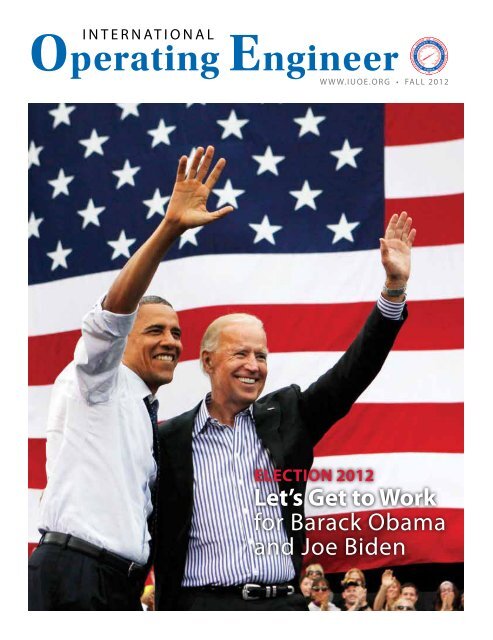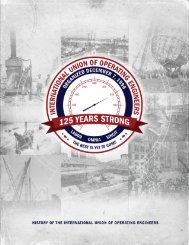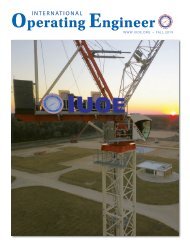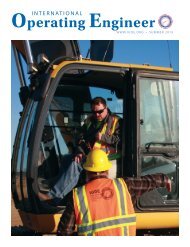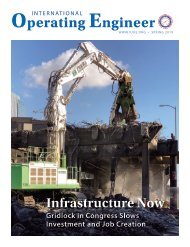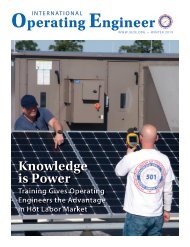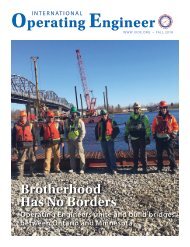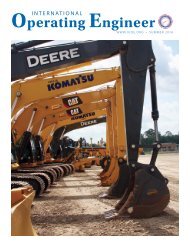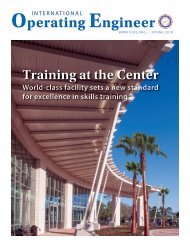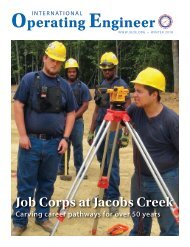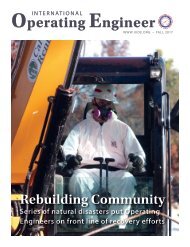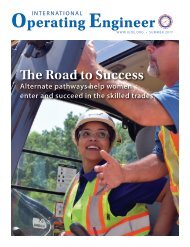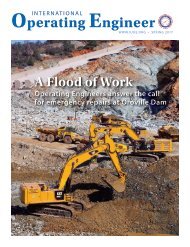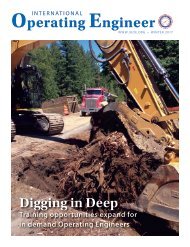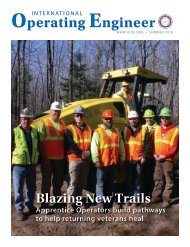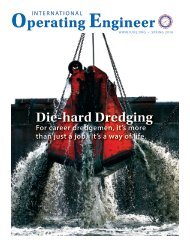Operating Engineer - Fall 2012
The quarterly magazine of the International Union of Operating Engineers.
The quarterly magazine of the International Union of Operating Engineers.
Create successful ePaper yourself
Turn your PDF publications into a flip-book with our unique Google optimized e-Paper software.
i n t e r n at i o n a l<br />
<strong>Operating</strong> <strong>Engineer</strong><br />
www.iuoe.org • fall <strong>2012</strong><br />
Election <strong>2012</strong><br />
Let’s Get to Work<br />
for Barack Obama<br />
and Joe Biden
i n t e r n at i o n a l<br />
<strong>Operating</strong> <strong>Engineer</strong><br />
<strong>Fall</strong> <strong>2012</strong> • Volume 155, No. 3<br />
Brian E. Hickey, Editor<br />
Jay Lederer, Managing Editor<br />
10 Local 139’s Bionic Operator<br />
The first civilian prosthetic Michelangelo hand<br />
15 Highway Bill Gets Out of Garage<br />
Congress approves, president signs major jobs bill<br />
16 Election <strong>2012</strong>: Special Series<br />
Who’s on your side?<br />
21 Power Aid<br />
Nuclear energy gets a boost from President Obama<br />
Departments<br />
05 From the General President<br />
06 Education & Training<br />
08 HAZMAT<br />
09 Healthcare<br />
14 Politics & Legislation<br />
24 Canadian News<br />
26 Around the Locals<br />
28 GEB Minutes<br />
32 In Memorium<br />
[cover] President Barack Obama and Vice President Joe Biden.<br />
[photo] Larry Downing/Reuters<br />
[left] One World Trade Center on the skyline of Lower Manhattan<br />
as people watch the sun set on the city of New York from<br />
a Pier in Hoboken, New Jersey, on September 9, <strong>2012</strong>.<br />
[photo] Gary Hershorn/Reuters<br />
2<br />
international operating engineer<br />
fall <strong>2012</strong> 3
International <strong>Operating</strong> <strong>Engineer</strong><br />
(ISSN 0020-8159) is published by the:<br />
International Union of<br />
<strong>Operating</strong> <strong>Engineer</strong>s, AFL-CIO<br />
1125 17 th Street, NW<br />
Washington, DC 20036<br />
Subscription Terms - $5 per year<br />
Change of Address - Requests must<br />
be submitted in writing to the IUOE<br />
Membership Department (address<br />
above). Include your new address,<br />
registration and local union number.<br />
POSTMASTERS – ATTENTION:<br />
Change of address on Form 3579<br />
should be sent to:<br />
International <strong>Operating</strong> <strong>Engineer</strong><br />
Mailing List Dept.<br />
1125 17th St., NW, 3rd Floor<br />
Washington, DC 20036<br />
Publications Mail Agreement No.<br />
40843045<br />
Return undeliverable Canadian<br />
addresses to:<br />
2835 Kew Drive<br />
Windsor, ON N8T3B7<br />
Printed in the U.S.A.<br />
International Union of <strong>Operating</strong> <strong>Engineer</strong>s<br />
AFL-CIO<br />
general officers<br />
James T. Callahan, General President<br />
Brian E. Hickey, General Secretary-Treasurer<br />
William C. Waggoner, First Vice President<br />
John M. Hamilton, Second Vice President<br />
Patrick L. Sink, Third Vice President<br />
Jerry Kalmar, Fourth Vice President<br />
Russell E. Burns, Fifth Vice President<br />
Rodger Kaminska, Sixth Vice President<br />
James M. Sweeney, Seventh Vice President<br />
Robert T. Heenan, Eighth Vice President<br />
Daniel J. McGraw, Ninth Vice President<br />
Daren Konopaski, Tenth Vice President<br />
Michael Gallagher, Eleventh Vice President<br />
Greg Lalevee, Twelfth Vice President<br />
Terrance E. McGowan, Thirteenth Vice President<br />
Louis G. Rasetta, Fourteenth Vice President<br />
trustees<br />
John M. Holliday III, Chairman<br />
John T. Ahern, Trustee<br />
Kuba J. Brown, Trustee<br />
Bruce Moffatt, Trustee<br />
James T. Kunz, Jr., Trustee<br />
engineers action resPonse netWorK<br />
Because elections matter<br />
Make your voice heard • Register for EARN today<br />
www.iuoe.org<br />
From the General President<br />
Stand with those who stand with us<br />
Obama-Biden best to lead on jobs, worker rights<br />
It seems today that the fastest<br />
growing occupation in America is<br />
political fact checker. Unfortunately,<br />
their very existence is necessary in an<br />
age when misinformation and even deliberate<br />
deception have become part of<br />
a win-at-all-cost mentality in political<br />
campaigns and too often seen during<br />
the so-called “news” on cable television.<br />
But, I don’t need those folks to tell<br />
me what’s really going on in America—I<br />
see it and I hear it every time I<br />
visit with members on the job or at the<br />
union hall. It’s in members’ voices—<br />
that sense of pride in a job well done<br />
today and the optimism that, if we continue<br />
to work hard and act with unity of<br />
purpose, our best days are still to come.<br />
Those of us in the skilled maintenance<br />
and heavy construction trades<br />
understand better than most how deep<br />
this Great Recession really was. We<br />
were the first to feel it, with an unemployment<br />
rate in construction that<br />
went as high as 27.1%, and we have<br />
been among the last to enjoy the benefits<br />
of the recovery. However, the<br />
economy is mounting a comeback under<br />
President Obama, evidenced by 29<br />
consecutive months of private-sector<br />
job growth and an unemployment rate<br />
in construction that has fallen back to<br />
11.3%, which is a four-year low.<br />
As you will see in the pages of this<br />
magazine, things like the recent passage<br />
of the federal transportation bill,<br />
the ground breaking on the Southern<br />
segments of the Keystone pipeline and<br />
the recent approval of two new nuclear<br />
reactors in Georgia promise to bring<br />
thousands more jobs online for <strong>Operating</strong><br />
<strong>Engineer</strong>s in the months and<br />
years ahead. As we get ever closer to<br />
Election Day, we must use our collective<br />
voice – and votes – to ensure that<br />
we keep moving forward on that path<br />
to prosperity.<br />
Republican presidential nominee<br />
Mitt Romney says this election should<br />
be about jobs and the economy. You<br />
won’t get an argument on that, but<br />
that’s where the agreement ends. Romney<br />
contends that if we just go back—<br />
back to more tax cuts for millionaires<br />
and billionaires, less regulation on Wall<br />
Street, more restrictions on unions, a<br />
repeal of Davis-Bacon prevailing wage<br />
and more so-called “right to work”<br />
laws—then our economy will thrive<br />
once more. Well, you don’t need a fact<br />
checker to know that theory is full of<br />
holes.<br />
The fact of the matter is, President<br />
Obama is the one who has worked relentlessly<br />
to expand job opportunities<br />
for <strong>Operating</strong> <strong>Engineer</strong>s and the middle-class—from<br />
signing an Executive<br />
Order on Project Labor Agreements<br />
and pushing through the American Recovery<br />
Act (better known as “the stimulus”),<br />
to saving the American auto<br />
industry and pursuing an aggressive<br />
strategy on domestic energy production.<br />
These are real accomplishments<br />
that spur economic growth and that<br />
can be felt by working families everywhere.<br />
President Obama has been steadfast<br />
in his position that a union wage<br />
is a fair wage. On the other hand, Mitt<br />
Romney has been unequivocal in his<br />
desire to bust unions, strip away collective<br />
bargaining rights and repeal prevailing<br />
wage laws. What Romney fails<br />
to acknowledge is that without labor<br />
unions, prevailing wages and worker<br />
safety provisions, millions more Americans<br />
will be negatively affected too.<br />
Labor unions, utilizing the collective<br />
bargaining process, were the<br />
engine that grew the American middle-class<br />
during a thirty year period<br />
following World War II. Since then, the<br />
decline in overall union membership<br />
tracks almost exactly with the decline<br />
in the share of income going to middleclass<br />
families. Romney’s vision is to tip<br />
[James T. Callahan]<br />
the scales even further, concentrating<br />
more wealth at the very top and creating<br />
a race to the bottom for low-wage,<br />
no benefit jobs.<br />
Brothers and Sisters, I urge you once<br />
again to look past highly volatile social<br />
issues and recognize the all out attack<br />
on organized labor and middle-class<br />
families. We must defeat the powers<br />
that conspire with corporate bosses<br />
to eliminate our collective bargaining<br />
rights.<br />
I ask you to imagine a Labor Department<br />
headed by the likes of Michele<br />
Bachmann or Sarah Palin, or a shuttered<br />
NLRB, or a Senate that overturns<br />
Davis-Bacon protection. These could<br />
become realities instead of just fears.<br />
We have entered an era of hostility<br />
towards labor not seen in nearly a century.<br />
This is a fight that we must wage<br />
right now for the survival of our bargained<br />
defined pension benefits and<br />
our family healthcare coverage. This is<br />
a fight that must continue beyond any<br />
election cycle. This attack is real and<br />
we must not falter.<br />
Once again, as an <strong>Operating</strong> <strong>Engineer</strong><br />
and your General President it is<br />
my duty and obligation to uphold the<br />
standards that those before us have<br />
fought so hard to achieve.<br />
Let the word go forth that no IUOE<br />
member’s standard of living will suffer<br />
due to the stroke of an American president’s<br />
pen without this union expending<br />
all its resources to combat those<br />
who serve at the knee of corporate special<br />
interests.<br />
4<br />
international operating engineer<br />
fall <strong>2012</strong> 5
Education & Training<br />
Local 101 All in with OECP<br />
All in with the <strong>Operating</strong> <strong>Engineer</strong>s Certification Program (OECP). That’s<br />
what Local 101 in Kansas and Missouri decided when they began using the OECP<br />
exclusively, discontinuing all other crane operating testing. “Certainly any decision<br />
like this has both potential risks and benefits, but we felt comfortable putting all<br />
of our crane operator certifications solely in the hands of a program managed<br />
by fellow <strong>Operating</strong> <strong>Engineer</strong>s. We have not been disappointed,” says Business<br />
Manager and International Vice-President Rodger Kaminska.<br />
One of the first locals to sign with the OECP, members of Local 101 have since<br />
been issued over 160 OECP certifications.<br />
Training Director Garry Edmondson states he too is very pleased with the<br />
program. “One major advantage the OECP has over similar programs is our ability<br />
as <strong>Operating</strong> <strong>Engineer</strong>s to direct the process. I also know that all of our efforts to<br />
support the OECP will only benefit our union and our members.”<br />
As a recently elected member of the OECP Board of Directors, Garry also<br />
commented on the cooperative attitude of the signatory contractors. “I cannot<br />
be more pleased with the backing by the employers. Once they see how the<br />
program works and the quality of the testing process, they become its most ardent<br />
supporters.”<br />
The OECP is only available to members of the IUOE. Any IUOE member in<br />
good standing meeting the program’s eligibility requirements can participate in<br />
OECP testing anywhere it is scheduled, even if not a member of the local where the<br />
testing is being conducted. There are no out-of-pocket expenses for members to<br />
participate in OECP testing.<br />
For further information about the program, contact the OECP at 951-351-4001<br />
or by e-mail at oecp@oecp.org.<br />
NTF Conferences<br />
Debut New Format<br />
Over the past several years, the<br />
National Training Fund (NTF) has<br />
sponsored an annual Training, Safety<br />
and Health Conference with numerous<br />
workshops and events taking place<br />
in a multi-day format. NTF tried a<br />
new approach in <strong>2012</strong>, with a series of<br />
one-day regional training conferences<br />
hosted by local unions.<br />
The format was in keeping with the<br />
NTF’s efforts to provide more regional<br />
training resources. The seven regional<br />
locations and craft-focused content<br />
were designed to make it easier for<br />
instructors, administrators and fund<br />
trustees to participate in an event<br />
closer to home. A total of 163 people<br />
from 57 different locals participated in<br />
one of the events.<br />
The <strong>2012</strong> meetings continued the<br />
practice of participants sharing upto-date<br />
information and the latest<br />
innovations in teaching and learning.<br />
There were brief reports from<br />
NTF staff on new courses, teaching<br />
resources, equipment and simulators<br />
available to local training programs.<br />
The setting for meetings created a<br />
participatory atmosphere with indepth,<br />
spirited discussions on craft<br />
training. The focus was on local training<br />
needs, accomplishments and ideas for<br />
moving forward so that IUOE members<br />
can be prepared for the future.<br />
The NTF thanks the following host<br />
locals for their assistance in making<br />
the <strong>2012</strong> training conference meetings<br />
a success: Locals 3, 68, 150, 286, 369,<br />
399, and 478.<br />
Apply Now for a Union Plus Scholarship<br />
Application deadline Jan. 31, 2013, for $150,000 in awards<br />
Union Privilege<br />
1125 15th Street, NW, Suite 300 • Washington, D.C. 20005<br />
Phone (202) 293-5330 • Fax (202) 293-5311<br />
www.UnionPlus.org<br />
News<br />
Washington, DC— Applications are now open for the 2013 Union Plus Scholarship Program,<br />
which provides $150,000 in scholarships to union members, their spouses and dependants.<br />
To apply, visit UnionPlus.org/Education. This year’s application is entirely online—allowing<br />
students to complete their application over time and save their responses. The application<br />
deadline is January 31, 2013.<br />
How the Scholarship Program Works<br />
In addition to demonstrating academic ability, applicants are required to submit essays of no<br />
more than 500 words describing their career goals, detailing their relationship with the union<br />
movement and explaining why they are deserving of a union scholarship.<br />
Individuals must be accepted into an accredited college or university, community college or<br />
recognized technical or trade school at the time the award is issued. Graduate school students<br />
are also eligible for Union Plus Scholarships. There is no requirement to have participated in<br />
any Union Plus program in order to apply.<br />
Since 1991, Union Plus has distributed more than $3.2 million in scholarships to working<br />
families.<br />
In addition to the Union Plus Scholarships, the following benefits help union families afford<br />
higher education:<br />
• Scholarships to help union members and leaders finish their degrees with an<br />
affordable, flexible and convenient online program at the National Labor College.<br />
• Discounts of 15 percent to 60 percent on college and graduate school test preparation<br />
courses from The Princeton Review. Includes classroom, online and private tutoring<br />
for the SAT ® , ACT ® , GMAT ® , LSAT ® , GRE ® and MCAT ® as well as college affordability<br />
and admissions online courses. Visit UnionPlus.org/CollegePrep or call 1-888-243-<br />
7737.<br />
Visit UnionPlus.org/Education for applications and benefit eligibility.<br />
Union Plus programs also include mortgages, insurance protection and money-saving offers on<br />
flowers, car rentals and AT&T wireless service. Union members can visit UnionPlus.org for<br />
more information.<br />
6<br />
international operating engineer<br />
fall <strong>2012</strong> 7
HAZMAT<br />
Healthcare<br />
MSHA Improves Working Conditions for Miners and<br />
<strong>Operating</strong> <strong>Engineer</strong>s who work under MSHA regulations<br />
CVS Caremark wins Competition, Continues to Provide<br />
IUOE Prescription Benefits<br />
The Assistant Secretary for the<br />
Mine Safety and Health Administration,<br />
Joseph Main, occasionally conducts<br />
meetings with interested labor<br />
organizations. On August 30, <strong>2012</strong> one<br />
such meeting was held. Among those<br />
represented were the International<br />
Union of <strong>Operating</strong> <strong>Engineer</strong>s (NTF—<br />
HAZMAT), United Miner Workers<br />
of America, Steelworkers, Laborers,<br />
Change to Win, the Teamsters, and the<br />
Appalachian Law Center. The purpose<br />
of this meeting was to update everyone<br />
regarding MSHA activities taking<br />
place over recent years.<br />
Three years ago there was a backlog<br />
of approximately 80,000 unsettled<br />
violations contested by mine operators.<br />
If violators can go unpunished<br />
regarding their violations of the Mine<br />
Act, there is little financial incentive<br />
for them to comply with health and<br />
safety rules and regulations. Mr. Main<br />
has increased the number of attorneys<br />
representing MSHA and while over<br />
the last three years there have been<br />
many additional violations issued, the<br />
backlog has been decreased to approximately<br />
52,000, a 28,000 caseload<br />
reduction.<br />
MSHA has increasingly focused<br />
on Miners’ Rights and Responsibilities<br />
under the Act, improving worker<br />
knowledge of their rights and causing<br />
a great increase of miners exercising<br />
these rights. One of the newer items<br />
now available is a 40-minute Miners’<br />
Rights and Responsibilities informational<br />
DVD for training purposes.<br />
Additionally, on the MSHA homepage,<br />
there is a large amount of information<br />
regarding miners’ rights/protections<br />
and miners’ representative rights/<br />
protections under the Act. There is<br />
an online miners’ rights program on<br />
[photo] Tom Barrows<br />
the MSHA homepage. To access the<br />
MSHA homepage simply type in www.<br />
msha.gov.<br />
The site is relatively easy to navigate<br />
and will be updated again on<br />
September 30, <strong>2012</strong>. The MSHA<br />
homepage gets an average of 1,600<br />
hits per day regarding miners’ rights.<br />
A guide to miners’ rights for miners’<br />
representatives is being developed.<br />
There are many cases today where<br />
miners have been returned to work as<br />
a result of their filing discrimination<br />
cases against the mine operator for<br />
firing them unjustly for such things<br />
as reporting violations, refusing to<br />
perform work which is hazardous, or<br />
reporting an on-the-job injury. There<br />
are cases where mine management<br />
officials have been punished for violating<br />
the Mine Act. Once word spreads<br />
among mine operators that miners are<br />
availing themselves of this legal right,<br />
discrimination against miners should<br />
decline.<br />
To improve health and safety at<br />
mines, MSHA has begun to apply the<br />
“Pattern of Violation” (POV) section<br />
of the Mine Act to improve safety and<br />
health at the most dangerous mines.<br />
Recently, there have been at least<br />
two mines placed on the POV with 28<br />
mines listed as potential POV mines.<br />
The first 14 mines placed on the “potential”<br />
list improved regarding violations<br />
and injuries went down by 51<br />
percent. This is a remarkable improvement<br />
as a result of the use of this long<br />
available tool. It has been reported<br />
that four percent of the mines, mostly<br />
coal mines, account for 50 percent of<br />
the paperwork—citations/orders—issued.<br />
Regarding Metal Nonmetal Mines<br />
(MNM), the hazard most cited by<br />
inspectors is the absence of guards on<br />
equipment, such as belt drives and<br />
other moving equipment, which could<br />
The IUOE recently completed a<br />
competition for the services of a pharmacy<br />
benefit manager (PBM). Following a rigorous<br />
three month competition conducted by the<br />
Burchfield Group, CVS Caremark has been<br />
selected for a three year pricing PBM contract<br />
beginning January 1, 2013. This award will be<br />
the fourth contract between IUOE and CVS<br />
Caremark.<br />
Using the purchasing power of 300,000<br />
members plus their dependents from 44 local<br />
health funds, this contract will establish a lower<br />
cost pricing structure for the purchase and<br />
administration of prescription drug benefits.<br />
Prescribed drugs represent approximately 30%<br />
of the total spending on health benefits by IUOE<br />
local health funds. Negotiating lower drug<br />
prices helps local funds limit increases to the hourly health & welfare contribution negotiated in employer agreements.<br />
PBM companies such as CVS Caremark and Express Scripts are the “middleman” between the pharmaceutical companies<br />
that make drugs and the pharmacy where members and their families purchase prescription drugs. PBM companies also<br />
provide mail order drugs at lower rates than retail pharmacies on health maintenance drugs.<br />
The IUOE hired the Burchfield Group, an independent company with expertise in the management of prescription drugs, to<br />
conduct the competition to select the new PBM contractor, help negotiate a new contract and to annually audit CVS Caremark<br />
to ensure the lowest pricing is provided.<br />
The award was unanimously endorsed after full consideration by a selection committee composed of experienced IUOE<br />
fund administrators. The purchasing power of the IUOE PBM coalition is clearly reflective in the outstanding pricing and<br />
guarantees achieved through this competition.<br />
catch and injure miners.<br />
The MSHA summary of fatalities<br />
which used to come out annually is<br />
now coming out quarterly. Reportedly,<br />
at mid-term this year, the mining<br />
industry is on its second best year<br />
ever regarding fatalities. However, Mr.<br />
Main stated that one fatality is one too<br />
many. Getting this information to the<br />
industry sooner gives the opportunity<br />
for other miners to be trained regarding<br />
the hazards in a timelier manner.<br />
In rule making, MSHA is working<br />
on the following: A Personal Dust<br />
Monitor (PDM) to give instantaneous<br />
readouts regarding exposure; a new<br />
HAZMAT continued<br />
penalty rule—Part 100; a new fall protection<br />
policy (this is in effect and provided<br />
at the end of this article); a high<br />
voltage rule for underground continuous<br />
miners; a mine examination rule;<br />
the incombustible materials in underground<br />
coal mines now has to be 80<br />
percent throughout the mine; and, in<br />
underground coal mines a proximity<br />
device to prevent crushing injuries in<br />
close places is being developed which<br />
shuts down equipment when a miner<br />
gets within a specified distance of the<br />
equipment.<br />
Training of the MSHA inspectors<br />
and management has improved.<br />
MSHA has trained near 100 percent<br />
of all inspectors regarding black lung<br />
issues and miners’ rights.<br />
Never before has more emphasis<br />
been placed on miner health and<br />
safety by MSHA than during recent<br />
years. It is up to our own labor force<br />
and especially our labor representatives<br />
(miners’ representatives) to keep<br />
up-to-date with the rules within the<br />
trades wherein we work regarding new<br />
training initiatives, worker rights, representative’s<br />
rights, etc. to ensure that<br />
our brothers and sisters have a safe<br />
work environment and are employable<br />
wherever there is work.<br />
8<br />
international operating engineer<br />
fall <strong>2012</strong> 9
Member Spotlight<br />
Local 139’s Bionic Operator<br />
Matt Razink is first civilian fitted with prosthetic Michelangelo Hand<br />
Matt Razink earns a living running a rock crusher.<br />
As part of that job, he repairs broken parts on the machine,<br />
operates a wheel loader and a skid steer, and repositions a<br />
moving conveyor belt that the crusher feeds.<br />
Outside the workplace, Razink can slice a tomato when<br />
making a sandwich and slip the finished product into a Zip-<br />
Lock bag, run a lathe, or hold a dinner plate in his left “hand”<br />
as he navigates the buffet line at a wedding reception.<br />
Not bad for a guy who lost his left hand and much of his<br />
left arm six years ago in a crusher accident in Wausau. Razink<br />
was pulling metal screening from the machine when the<br />
glove on his left hand entangled in the machine. Doctors had<br />
no choice but to amputate below the elbow.<br />
“I really think that things happen for a reason,” the<br />
journeyman 139er said during a break from operating a<br />
crusher in August, where Highway 13 is being rebuilt in<br />
Colby. “My wife says it’s all about finding your new normal.<br />
We had to find a new normal after my accident. This is what<br />
it is.”<br />
While on the clock for Medford-based James Peterson<br />
Sons Inc., Razink prefers a traditional, “body-powered”<br />
prosthetic arm, fitted with a swivel that acts somewhat like<br />
a wrist. The joint holds numerous attachments, from a basic<br />
hook to any number of wrenches or other tools Razink keeps<br />
at the ready.<br />
“There’s nothing out there heavy duty enough to take the<br />
abuse of running a rock crusher,” he said, explaining why oldschool<br />
prosthetics work best in his dust-filled environment.<br />
Off the job, Razink has the option of wearing a state-ofthe-art<br />
robotic device called the Michelangelo Hand. In<br />
February, during Anderson Cooper’s live daytime-television<br />
talk show, Razink became the first civilian to receive the<br />
battery-operated device. It is the first such prosthetic with an<br />
electric opposable thumb.<br />
Wounded soldiers test hand<br />
Otto Bock HealthCare, a company in Duderstadt,<br />
Germany, created the hand, then turned over beta-testing<br />
to Advanced Arm Dynamics of Redondo Beach, Calif.<br />
The testing lasted for 4.5 years and involved soldiers who<br />
lost limbs to the wars in Iraq and Afghanistan, said Carol<br />
Sorrels, Advanced Arm’s national director of marketing and<br />
communications.<br />
Staff from the Maple Grove, MN, office of Advanced<br />
Arm fitted and trained Razink to manipulate his new limb.<br />
Sorrels arranged for the appearance of Razink and his family<br />
on Anderson Cooper’s program after electronic and print<br />
media in the Twin Cities reported on his story beginning<br />
last December. During the “Anderson” show, the Milwaukee<br />
Brewers invited their fan and the Razink family to the team’s<br />
spring training camp in Phoenix. They accepted.<br />
Team officials followed up with another offer to him and<br />
on June 3, Razink delivered the ceremonial first pitch prior<br />
to the Brewers-Pittsburgh Pirates game at Miller Park in<br />
Milwaukee.<br />
Razink said he tried other robotic limbs, “But before this<br />
one, a robotic hand was basically just a pinchers. You had to<br />
raise your arm up at a very high angle to pick up something.<br />
With this new one I can pick up a 2-liter bottle of pop.”<br />
[left] Matt Razink runs a crusher using his conventional prosthetic<br />
arm. [photo] Local 139/Dave Backmann<br />
[center] Razink shakes hands with television’s Anderson Cooper.<br />
[photo] Advanced Arm Dynamics<br />
[right] Razink throws out the first pitch before a Milwaukee Brewers<br />
home game. [photo] Milwaukee Brewers/Scott Paulus<br />
Workers’ compensation covered the $100,000 cost of the<br />
Michelangelo Hand, he said.<br />
“This hand has a much more natural shape than others<br />
(previous models) and, after a few seconds of not being<br />
used, it relaxes into a natural position like your hand would,<br />
or mine,” Sorrels said. “It’s called the Michelangelo Hand<br />
because of its beauty and human likeness. Matt wears a glove<br />
over his that is skin-colored and it protects the hand.”<br />
10<br />
international operating engineer<br />
fall <strong>2012</strong> 11
Member Spotlight<br />
A motor in the palm operates the four fingers. A second<br />
motor engages the thumb. Sensors attached to the upper<br />
portion of Razink’s left arm detect muscle movements. That<br />
allows him to work the digits. “I kind of think about how I’m<br />
going to move the hand, up or down, sideways, or whatever<br />
and it happens,” he explained.<br />
Razink is fortunate to be the first civilian to receive the<br />
hand for a number of reasons. But Sorrel said it helped that,<br />
“He was in the right place at the right time.<br />
“He also is a trans-radial prosthetic user (his amputation<br />
occurred below the elbow) and he has good signals from the<br />
residual limb,” she said. “And he was very interested and very<br />
motivated.”<br />
Razink has a business relationship with Advanced Arm<br />
as well. Midwest ProCAD LLC, the company he founded to<br />
manufacture prosthetic custom assistive devices, holds an<br />
exclusive contract to sell the devices through Advanced Arm.<br />
Although the near-fatal accident claimed Razink’s arm, it<br />
also sparked an inventive and entrepreneurial spirit. In the<br />
wake of that life-altering event he has designed and crafted<br />
a large inventory of non-robotic prosthetics in the basement<br />
workshop of his Medford home. ¬<br />
He purchased and taught himself how to use Computer-<br />
Assisted Design software to design the prothestics and a lathe<br />
to manufacture them.<br />
Working on his own, Razink developed a two-way<br />
prothestic “wrist” and a four-way counterpart. They each<br />
hold numerous attachments. Those range from Vice-<br />
Grip pliers of varying designs, to box wrenches, Crescent<br />
wrenches, hammer heads, fishing poles, crossbows and a<br />
chef’s knife. They can be viewed on his company’s website:<br />
www.midwestprocad.com<br />
“A lot of the stuff I make up is geared to the farmer who<br />
lost his arm in a corn picker and doesn’t have workers’ comp,”<br />
Razink said. “I make wrenches that he can afford to buy so he<br />
can go back to work.”<br />
One of his projects involved retrofitting a 40-year-old<br />
“farmer’s hook” for use with a robotic arm.<br />
A Mr. Fix-it<br />
The husband and father of three children paints himself<br />
as more of a mechanic than an Operator of heavy equipment.<br />
Summers, he’s responsible for keeping a crusher running.<br />
Winters, he repairs equipment in the James Peterson Sons’<br />
shop.<br />
Despite his disability he is almost constantly in motion<br />
while supervising the crusher operation. He views his work<br />
environment as a research-and-development laboratory for<br />
new prosthetics. “I’m always fixing things that break,” he said,<br />
standing in a workshop adjoining the crusher.”<br />
Jeff Peterson, vice president of James Peterson Sons,<br />
12<br />
international operating engineer<br />
[above] Matt Razink runs a rock crusher and wheel loader as part of<br />
his responsibilities working for James Peterson Sons Inc.<br />
[photos] Local 139/Dave Backmann<br />
recognized his employee’s ambition. “He does a great job,”<br />
Peterson said. “He never lets his handicap slow him down.<br />
“He is very ingenious on how he can do things without<br />
his hand.”<br />
[story by] Dave Backmann, Managing Editor, Local 139<br />
fall <strong>2012</strong> 13
Politics & Legislation<br />
Pipeline Update: Construction Work Begins on Gulf Coast Segment<br />
While Permitting Continues on Keystone XL<br />
The Obama Administration approved the final permits<br />
for TransCanada Corp’s Gulf Coast segment of the Keystone XL<br />
pipeline and construction is underway on the roughly 500-mile<br />
pipeline from Cushing, OK, to Port Arthur, TX. This segment of<br />
the project is designed to eliminate the supply glut at the key oil<br />
hub at Cushing. An environmental review is still underway for<br />
the Presidential Permit required to build the 1,200-mile section of<br />
pipeline that will cross the Canadian border, bringing crude from<br />
Alberta, as well as North Dakota and Montana down to refineries<br />
in the Midwest and Gulf Coast.<br />
In January, the State Department delayed a decision on<br />
the $7.6 billion pipeline application, citing concerns about<br />
the northern portion of the route near a major aquifer in the<br />
Sandhills area of Nebraska. TransCanada has been working<br />
closely with Nebraska officials to develop the new route that will<br />
avoid sensitive ecological areas and it hopes to have U.S. State<br />
Department approval for the northern section early next year.<br />
The alternative route was submitted in<br />
an environmental report to state officials and<br />
was developed “based on extensive feedback<br />
from Nebraskans, and reflects our shared<br />
desire to minimize the disturbance of land<br />
and sensitive resources in the state,” said<br />
Russ Girling, TransCanada’s president and<br />
chief executive officer.<br />
TransCanada has signed a Project Labor<br />
Agreement with the four pipeline unions for<br />
the bulk of the project, the biggest private<br />
project on the books in the United States. The<br />
project expects to create 20,000 high-quality<br />
jobs during the pipeline’s construction<br />
phase, including about 4,000 <strong>Operating</strong><br />
<strong>Engineer</strong> jobs. It’s also estimated to spur<br />
more than $20 billion in new spending for the<br />
U.S. economy and stimulate more than $585<br />
million in new state and local taxes in states<br />
along the pipeline route during construction.<br />
Congress Passes and President<br />
Signs Highway Bill<br />
Congress approved a $105 billion highway bill that<br />
will create jobs and guide the nation’s transportation policy<br />
for the next two years. The bipartisan deal came about one<br />
day before the ninth short-term funding extension was to<br />
expire, averting a shutdown of the program. The passage of<br />
the highway bill clears<br />
the way for <strong>Operating</strong><br />
<strong>Engineer</strong>s and other<br />
construction workers<br />
to get back on the job<br />
rebuilding the country’s<br />
vital transportation<br />
network.<br />
President Obama<br />
quickly signed the bill,<br />
called Moving Ahead<br />
for Progress in the 21st<br />
Century Act (MAP-<br />
21), stating, “This bill<br />
will keep thousands<br />
of construction<br />
workers on the job<br />
rebuilding our nation’s<br />
infrastructure. These<br />
steps will make a real<br />
difference in the lives of<br />
millions of Americans…<br />
But make no mistake<br />
— we’ve got a lot more<br />
to do. The construction<br />
industry, for example,<br />
was hit brutally hard<br />
when the housing<br />
bubble burst. So it’s not<br />
enough just to keep construction workers on the job doing<br />
projects that were already underway. There’s work to be<br />
done building roads and bridges…and there are thousands<br />
of construction workers ready to do it.”<br />
IUOE General President Callahan singled out Senator<br />
Barbara Boxer (D-CA) for her role in enacting the critical<br />
jobs legislation, saying that “her tenacity and leadership led”<br />
to MAP-21 becoming law. Boxer, chairman of the Senate<br />
committee that oversees transportation and infrastructure,<br />
helped craft the bill and led negotiations between the House<br />
and the Senate. “Millions of workers were counting on us,<br />
and thousands of businesses — and we came through,” Sen.<br />
Boxer told reporters after the vote.<br />
The federal government funds about 40% of all road<br />
and highway improvements. MAP-21 basically maintains<br />
current investment levels, providing $105 billion over two<br />
years and delivering $13 billion in new revenue for highway<br />
and transit spending. The bill maintains key priorities for<br />
the <strong>Operating</strong> <strong>Engineer</strong>s, including full application of Davis-<br />
Bacon prevailing wages. It cuts bureaucracies and programs,<br />
streamlines the environmental permitting process, and<br />
increases innovative financing for mega-projects. According<br />
to congressional estimates, the bill would protect roughly 1.8<br />
million jobs that would have been lost if Congress had not<br />
acted. Provisions of the bill also would create an estimated 1<br />
million new jobs, Boxer said.<br />
Passage of the highway bill was the top legislative<br />
priority for the IUOE during this congressional session. The<br />
number of jobs created for heavy equipment operators in<br />
this legislation dwarfs any other single piece of legislation<br />
out there. The bill received the strong support of both the<br />
business and labor communities.<br />
14<br />
international operating engineer<br />
fall <strong>2012</strong> 15
Election <strong>2012</strong>: Special Series<br />
The Obama Record<br />
The Romney Record<br />
As soon as President Obama took office, he issued<br />
an Executive Order encouraging the use of Project Labor<br />
Agreements (PLAs), which reversed an earlier prohibition<br />
executed by George W. Bush. Throughout his first term,<br />
President Obama has consistently stood up for workers’<br />
rights and invested in America’s middle-class.<br />
President Obama enacted, over nearly unanimous<br />
Republican opposition, an economic recovery plan<br />
(commonly called “the stimulus”) that included the largest<br />
ever, one-time construction investment the nation has<br />
ever seen. It is no exaggeration to say that the construction<br />
economy may have completely collapsed if he had not<br />
invested $100 billion into building roads, bridges, schools,<br />
water systems, and more. The stimulus contained prevailing<br />
wages for construction and service workers, and contained<br />
strong Buy America requirements.<br />
Still, the severity of the recession caused the<br />
unemployment rate to reach just over 27% in the<br />
construction economy by 2010, affecting thousands<br />
of <strong>Operating</strong> <strong>Engineer</strong>s. Although the recovery has<br />
been slow, the economy has posted consistent gains<br />
and continues to move in a positive direction. While<br />
the unemployment rate in construction remains too<br />
high, it has dropped considerably, currently down to<br />
11.3%, reaching its lowest level in the past four years.<br />
Even during these difficult times, President Obama has<br />
delivered major accomplishments to <strong>Operating</strong> <strong>Engineer</strong>s<br />
and middle-class workers. In 2010, President Obama signed<br />
legislation to restore prevailing wages to America’s biggest<br />
water and wastewater construction program. Because of<br />
a legal loophole, construction workers had not been paid<br />
federal prevailing wages on sewer and water projects since<br />
1995.<br />
President Obama also signed a two-year, bipartisan<br />
highway bill called MAP-21. Supported strongly by the<br />
IUOE, the legislation increases innovative financing and<br />
streamlines approval processes for quicker project start-up.<br />
While President Obama has had major legislative<br />
accomplishments during his first term, Republicans in<br />
Congress have consistently tried to block his agenda, forcing<br />
the president to use his executive authority to create jobs for<br />
<strong>Operating</strong> <strong>Engineer</strong>s and other construction workers.<br />
As part of his “We Can’t Wait Initiative,” President<br />
Obama used his authority to accelerate seven significant<br />
port projects, 15 major energy projects, and expedited four<br />
huge bridge and rail projects putting thousands of <strong>Operating</strong><br />
<strong>Engineer</strong>s on jobs all across the country.<br />
[photo] Pete Souza for the White House<br />
Who’s on<br />
The Obama-Biden Agenda<br />
“I believe our economy is stronger when workers are<br />
getting paid good wages and good benefits. I believe the<br />
economy is stronger when collective bargaining rights are<br />
protected. I believe all of us are better off when we’ve got<br />
broad-based prosperity that grows outwards from a strong<br />
middle class. I believe when folks try and take collective<br />
bargaining rights away by passing so-called “right to work”<br />
laws that might also be called “right to work for less,” laws --<br />
that’s not about economics, that’s about politics.”<br />
“That’s why we’ve reversed harmful decisions designed<br />
to undermine those rights. That’s why we passed the Fair<br />
Pay Act to help stop pay discrimination. That’s why we’ve<br />
supported Davis-Bacon. That’s why we reversed the ban<br />
on Project Labor Agreements, because we believe in those<br />
things as part of a strategy to rebuild America.”<br />
“And as long as I’m your President, I’m going to keep it<br />
up. I am going to keep it up -- because the right to organize<br />
and negotiate fair pay for hard work, that’s the right of every<br />
American, from the CEO in the corner office all the way to<br />
the worker who built that office.” [Remarks by President Obama, April 30, <strong>2012</strong>]<br />
The Romney-Ryan Agenda<br />
“One of the first things that I’ll do actually on Day One<br />
is I will end the government’s favoritism toward unions on<br />
contracts and I will fight to repeal Davis-Bacon.” [CNN Republican<br />
Presidential Debate, 2/22/12]<br />
The Romney/Ryan budget would slash federal<br />
transportation funding by 46% [The House Committee on the Budget,<br />
Democrats, Democratic Amendments to the Republican 2013 Budget Resolution (March 23, <strong>2012</strong>)<br />
at 4.] Their budget proposal would cut at least half a million<br />
transportation jobs in their first year in office. [Center for American<br />
Progress, New Ryan Budget Disinvests in America, 3/20/12]<br />
A former Governor of Massachusetts said the<br />
Romney transportation legacy was “a wreck.” Romney<br />
left the Commonwealth with over $10 billion in deferred<br />
maintenance costs.<br />
“Romney believes that Right-to-Work legislation is the<br />
appropriate course for states, and he will use the bully pulpit<br />
of the presidency to encourage more states to move in that<br />
direction.” [Believe in America: Mitt Romney’s Plan for Jobs and Economic Growth, page 109]<br />
[photo] Shannon Stapleton/Reuters<br />
Mitt Romney’s record demonstrates that he<br />
doesn’t understand the plight of the middle class. After<br />
years of manipulating the financial system to create wealth<br />
for investors as CEO of Bain Capital, Romney continued<br />
his disregard for middle-class workers as Governor of<br />
Massachusetts. Governor Romney vetoed legislation to<br />
increase workers’ rights and tried to undermine construction<br />
workers’ wages by exempting thousands of projects from the<br />
state’s prevailing wages laws.<br />
“[The Romney administration proposed to] exempt<br />
public construction jobs costing $100,000 or less and those<br />
in smaller communities from the state’s prevailing wage law.”<br />
[Elizabeth W. Crowley, “Budget Ax <strong>Fall</strong>s; Local Aid Proposals Outrage Unions, Mayors,” The Boston<br />
Herald, 1/31/03]<br />
your side?<br />
In an opinion column, Romney bragged that he vetoed<br />
legislation that would make it easier for workers to exercise<br />
their rights to form a union. [Mitt Romney, Op-Ed,<br />
“Viewing Unions From The Right: Cautionary Tale Of Card Check,” The<br />
Washington Times, 3/25/09]<br />
Romney continued his assault on middleclass<br />
workers. He proposed reducing<br />
unemployment benefits for laid-off workers.<br />
He also proposed increasing eligibility<br />
requirements for unemployment, making it<br />
more difficult for laid-off workers to access<br />
the insurance system that they had paid into.<br />
[Boston Herald, 6/23/05]<br />
According to economists at Northeastern University in<br />
Boston, while Romney was Governor of Massachusetts, the<br />
state had just about the worst economic performance of any<br />
state in the nation. During the Romney years, Massachusetts:<br />
• Ranked 47th in job growth. The state actually lost<br />
8,500 workers. [Boston Globe, July 29, 2007]<br />
• Lost 14 percent of its manufacturing job-base. The<br />
loss was double the rate that the nation as a whole lost<br />
in manufacturing jobs and the third worst of any state<br />
in the nation. [Boston Globe, July 29, 2007]<br />
• Piled on more debt than any other state. Romney left<br />
Massachusetts residents with the highest per capita<br />
debt in the nation. [Five Facts about Mitt Romney’s Massachusetts Economy,<br />
Think Progress, 6/4/12]<br />
Find more background on both candidates, including<br />
video, at www.iuoe.org and click on “<strong>2012</strong> Elections.”<br />
16<br />
international operating engineer<br />
fall <strong>2012</strong> 17
TWO VISIONS<br />
ONE CHOICE<br />
FOR MIDDLE-CLASS FAMILIES<br />
Election <strong>2012</strong>: Special Series<br />
CREATING JOBS BY INVESTING IN Roads,<br />
Bridges and Highways.<br />
Obama supports investing in America’s<br />
crumbling infrastructure. His plan will create<br />
jobs and make the country more competitive<br />
in the global economy.<br />
(New York Times, 10/11/10)<br />
KILLING JOBS BY SLASHING<br />
INFRASTRUCTURE INVESTMENTS.<br />
The Romney-Ryan transportation budget<br />
would cut federal highway spending over<br />
30% leading to the elimination of more than<br />
640,000 construction jobs.<br />
(Washington Post, 3/20/12; American Public Transportation Association,<br />
10/09; Federal Highway Administration, 2007)<br />
STANDING UP FOR AMERICAN WORKERS.<br />
Obama supports the use of PLAs on federal<br />
projects, backs Davis-Bacon wage laws and<br />
has fast-tracked major infrastructure projects.<br />
(Wall Street Journal, 4/13/10)<br />
FIGHTING FOR FAIR TAXES.<br />
Obama believes that the richest 2% of<br />
Americans should pay their fair share of taxes.<br />
(ABC News, 6/26/12)<br />
[photo] Mark Cornelison/Lexington Herald-Leader<br />
[photo] Evan Vucci/AP<br />
OUTSOURCING AMERICAN JOBS.<br />
Romney has been called a “pioneer” of<br />
outsourcing as CEO of Bain Capital, and vows<br />
to end PLAs, repeal Davis-Bacon and push for<br />
a national “right-to-work” law.<br />
(Washington Post, 6/21/12; ABC speech, 2/23/12)<br />
TAXING THE MIDDLE CLASS.<br />
The non-partisan Tax Policy Center finds that<br />
Romney’s plan will actually raise taxes by<br />
$2,000 for middle-class households while<br />
cutting taxes for wealthy people like him.<br />
(CBS News, 8/1/12)<br />
THE CHOICE IS CLEAR: RE-ELECT PRESIDENT OBAMA<br />
VOTE TUESDAY, NOVEMBER 6TH<br />
MITT ROMNEY: WRONG FOR WORKING FAMILIES<br />
VOTE TUESDAY, NOVEMBER 6TH<br />
For more information, visit www.iuoe.org<br />
18<br />
international operating engineer<br />
fall <strong>2012</strong> 19
Feature<br />
Power Aid<br />
Nuclear energy production gets a boost from President Obama<br />
During President Barack Obama’s first term in<br />
office, the nuclear power industry has entered what many<br />
observers are calling “a nuclear renaissance.” President<br />
Obama’s all-of-the-above energy strategy is putting<br />
thousands of Americans back to work -- building wind<br />
turbines, increasing domestic oil and gas production and reenergizing<br />
the nuclear industry.<br />
Not only has the Obama Administration approved the first<br />
permits to build the first new nuclear reactors in a generation,<br />
it has also developed a grant program to encourage<br />
the development of small modular reactors. The grant<br />
program, administered by the Department of Energy, will<br />
award two grants, with an eye towards expanding domestic<br />
manufacturing capacity in order to build and export the key<br />
components around the globe.<br />
Prior to Obama Administration approval of two new<br />
reactors at Plant Vogtle in Georgia this year, no nuclear<br />
reactors had been permitted in the United States since the<br />
accidental partial meltdown of the Three Mile Island reactor<br />
in 1979.<br />
Just as important as the approval to build the plant,<br />
President Obama extended a sizable federal loan guarantee<br />
– over $8 billion – for<br />
the project to assist<br />
with financing. Federal<br />
government support<br />
was vital as project<br />
owners were struggling<br />
to finance the massive<br />
undertaking on Wall<br />
Street. In fact, without<br />
federal financial<br />
assistance, the Plant<br />
Vogtle project would not<br />
be built and about 2,000 construction workers on the job now<br />
would be looking for other work.<br />
The International Union of <strong>Operating</strong> <strong>Engineer</strong>s<br />
successfully fought in the legislative process to secure Davis-<br />
Bacon prevailing wages on the federal loan-guarantee<br />
program. President Obama signed the legislation requiring<br />
Davis-Bacon prevailing wages, which led Georgia Power, a<br />
subsidiary of the Southern Company, to manage construction<br />
of the reactors with a Project Labor Agreement.<br />
The project is expected to cost nearly $14 billion and the<br />
construction phase alone is expected to last ten years. Once<br />
built, the nuclear plant will employ 800 workers and generate<br />
over 2,200mW of power – enough energy to power 2.3 million<br />
homes. The project will employ about 4,000 construction<br />
workers and there are currently about 2,000 workers on site<br />
today.<br />
Another aspect of the nuclear renaissance is the<br />
development of American-made, small modular reactors.<br />
The White House announced new grant funding totaling<br />
$450 million to support this first-of-its-kind engineering from<br />
design certification through licensing for two reactors over<br />
the next five years. [continued on page 23]<br />
[left]<br />
Plant Vogtle in Georgia is<br />
the first to gain approval<br />
for construction of new<br />
reactors since 1979.<br />
[photo] Southern<br />
Company<br />
[right]<br />
President Barack Obama<br />
and Secretary of Energy<br />
Steven Chu.<br />
[photo] Google Images<br />
20<br />
international operating engineer<br />
fall <strong>2012</strong> 21
“The Obama Administration and the Energy Department<br />
are committed to an all-of-the-above energy strategy that<br />
develops every source of American energy, including nuclear<br />
power, and strengthens our competitive edge in the global<br />
clean energy race,” said Energy Secretary Steven Chu.<br />
Manufacturing these reactors domestically will offer<br />
the United States important export opportunities and is<br />
expected to advance America’s competitive edge in the<br />
global clean energy race. Small modular reactors, which are<br />
approximately one-third the size of current nuclear plants,<br />
have compact, scalable designs that are expected to offer a<br />
host of safety, construction and economic benefits.<br />
Companies that employ <strong>Operating</strong> <strong>Engineer</strong>s are pursuing<br />
those grant funds and have sought the support of the union.<br />
The IUOE is proudly supporting a proposal from Ameren<br />
in Missouri, partnering with Westinghouse, for the grant<br />
assistance. Members of Local 148 maintain and operate the<br />
existing Ameren facility in Callaway County, Missouri. In a<br />
letter to Secretary Chu in support of Ameren’s application,<br />
General President Callahan said, “The International Union<br />
of <strong>Operating</strong> <strong>Engineer</strong>s stands ready to work with our<br />
energy industry partners in the effort to develop this critical<br />
technology.”<br />
[left]<br />
The 560-foot tall Heavy Lift Derrick (HDL), one of the biggest cranes<br />
in the world, will be used for the Plant Vogtle project.<br />
[middle]<br />
General President Callahan in the cab of this high-tech behemoth.<br />
[below]<br />
An IUOE delegation was invited to tour the Plant<br />
Vogtle project and get a closer look at the HDL.<br />
Pictured from left to right: Allen Braswell, Business<br />
Manager, Local 474; Ray Poupore, Executive Vice-<br />
President, NCA II; IUOE General President James Callahan;<br />
Dave Hanley, Business Agent, Local 474; Red<br />
Patterson, IUOE Southern Regional Director; and<br />
Donnie Blackburn, Local 474.<br />
[photos] Shaw/Southern Company<br />
22<br />
international operating engineer<br />
fall <strong>2012</strong><br />
23
Canadian News<br />
Diamond Jubilee medal for<br />
Local 793’s Gallagher<br />
Local 882 strikes for<br />
first contract<br />
Remembering B.C.’s worst industrial disaster<br />
reinforces need for safety at all times<br />
Mike Gallagher, Business<br />
Manager of IUOE Local 793 has been<br />
awarded a Queen Elizabeth II Diamond<br />
Jubilee Medal.<br />
Gallagher was presented with the<br />
medal by Oakville MPP Kevin Flynn at a<br />
luncheon on June 29 following the Gary<br />
O’Neill Memorial Golf Tournament in<br />
Milton.<br />
Created to mark the celebration of<br />
the 60th anniversary of the coronation of<br />
Queen Elizabeth, the commemorative<br />
medals are being presented<br />
throughout <strong>2012</strong> to individuals who<br />
have made a significant contribution<br />
to their community, country and<br />
internationally on behalf of Canada.<br />
The award recognizes Gallagher’s<br />
involvement in numerous charitable<br />
projects in the community and his<br />
contributions to Canada, including<br />
two major Local 793 projects — raising<br />
money to send a bulldozer to help<br />
rebuild an orphanage in Kenya, and<br />
raising funds to help the Red Cross<br />
support victims of the earthquake that<br />
happened in Haiti earlier this year.<br />
Gallagher told the crowd at the<br />
luncheon he was honored to receive<br />
the medal, but that he couldn’t have<br />
accomplished it without the support<br />
of his industry, the union, and Gary<br />
O’Neill, the late Local 793 president<br />
— Gallagher dedicated the medal to<br />
O’Neill, who was also a friend of his.<br />
“I haven’t done any of this on my<br />
own,” said Gallagher. “It was done with<br />
the co-operation of a great many people<br />
and with the support of the members of<br />
Local 793.”<br />
This is the second time that Gallagher<br />
has been honored with a jubilee medal<br />
— receiving the Queen’s Jubilee Medal<br />
in 2002.<br />
[below]<br />
International Union of <strong>Operating</strong> Engingeers<br />
Local 793 business manager Mike<br />
Gallagher was presented with a Queen<br />
Elizabeth II Diamond Jubilee Medal by<br />
Oakville MPP Kevin Flynn on June 29.<br />
IUOE Local 882 went out on strike for a<br />
first collective bargaining agreement on July<br />
9. Pickets went up outside the Richmond<br />
Olympic Oval as a result of <strong>Engineer</strong>s and<br />
Building Service Workers voting 100 percent<br />
to strike for job security. Local 882 Business<br />
Manager Saundra Taylor strategically<br />
staged the strike to coincide with a world<br />
class badminton event being staged at the<br />
Olympic Oval. The strike lasted two days<br />
and was supported on the picket lines by<br />
members of Locals 115 and 963.<br />
[above, left to right] IUOE Local 882 President<br />
Adrian David, British Columbia Federation of<br />
Labour Secretary-Treasurer Irene Lanzinger,<br />
IUOE Local 963 Business Manager Tim DeVivo<br />
and Local 963 President Tim Chester.<br />
[below, left to right] IUOE Local 115 Business<br />
Representative Bob Higgs, IUOE Local 882<br />
Business Representative Darryl Westfall and<br />
IUOE Local 115 Business Representative Everett<br />
Cummings.<br />
Safety and quality training<br />
are at the top of Local 115’s priorities.<br />
The British Columbia local is in the<br />
forefront of advocating for better<br />
safety regulations and training for<br />
the construction industry. “We never<br />
miss an opportunity to press home the<br />
message that all workers are entitled to<br />
return safely home at the end of their<br />
work day,” said Business Manager Brian<br />
Cochrane.<br />
Retired crane operator Brother<br />
Ed Mills was laid off from work on<br />
the Ironworkers Memorial Bridge<br />
in Vancouver just days before its<br />
catastrophic collapse on June 17, 1958.<br />
On that day, 79 workers plunged 175<br />
feet into Burrard Inlet when one of<br />
the spans collapsed; 18 people died<br />
instantly. A diver died two days later.<br />
Over the duration of the project, four<br />
more workers were killed.<br />
Construction is a dangerous<br />
business and that message is reinforced<br />
every year when ironworkers, their<br />
friends in organized labour and their<br />
families gather at the south end of the<br />
bridge to remember the worst industrial<br />
disaster in the history of the province.<br />
This year, Ed and his son (Local<br />
Union President Wayne Mills), Business<br />
Manager Brian Cochrane and Financial<br />
Secretary Don Swerdan were in<br />
attendance.<br />
“I lost a lot of friends on that job,”<br />
recalled Ed. “A lot of those guys were<br />
already retired. They [the contractor]<br />
needed their skills, so they brought<br />
them out of retirement to do the work.”<br />
With 50 years of crane work to<br />
his credit, the former World War II<br />
paratrooper worked on many large<br />
projects including dry docks, pulp mills<br />
and bridges.<br />
“I loved my work,” he said, adding<br />
that bridges are the most memorable—<br />
and the most dangerous. “I worked<br />
on the Port Mann Bridge in 1963. One<br />
day, a train going along the tracks<br />
below derailed and headed into the<br />
river. I helped rescue the engineer and<br />
fireman.”<br />
While he enjoyed his work, Mills said<br />
he’s also seen his share of injuries and<br />
experienced a few himself. “I got pain in<br />
my legs and back,” he said. “The doctor<br />
says it’s from pushing levers all day.”<br />
So what does he advise new workers<br />
entering the trade? “Be careful,” he<br />
stressed. “Don’t take chances just to<br />
hurry. Be safe.”<br />
Hard as it is to believe, several years<br />
ago, the B.C. government removed<br />
regulations requiring the certification<br />
of crane operators. “While you had<br />
to have a licence to drive a scooter, it<br />
would have been legal for anyone off<br />
the street to operate a tower crane or<br />
mobile crane,” said Cochrane. “The<br />
local union launched into a concerted<br />
effort with hundreds of hours of<br />
meetings and a sophisticated public<br />
information campaign but we forced<br />
the government to bring back crane<br />
certification.”<br />
There are many large industrial and<br />
infrastructure projects under way in<br />
the province and a shortage of skilled<br />
tradespeople in several areas. That<br />
has led to great pressure on operating<br />
engineers and all construction workers<br />
to put in long hours and maintain a<br />
high level of productivity. Cochrane<br />
said apprentices and all members are<br />
being reminded of the importance of<br />
never putting speed ahead of safety. In<br />
B.C., workers are protected by law from<br />
having to undertake unsafe work.<br />
24<br />
international operating engineer<br />
fall <strong>2012</strong> 25
Around the Locals<br />
Local 926<br />
Rex, Georgia<br />
For the fifth consecutive year,<br />
IUOE Local 926 members and<br />
affiliates participated in a Charity<br />
Sporting Clay Shoot, hosted by<br />
United Way of Bartow County<br />
at Barnsley Gardens Shooting<br />
Grounds in Adairsville, GA.<br />
[right]<br />
Dale Wolfe takes aim.<br />
[below; left to right]<br />
Front: Tip Pirkle, Phil McEntyre, Johnny<br />
Spann, Paul Rose, Ray Dameron<br />
Back: Scott McEntyre, Dale Wolfe,<br />
Ryan Wolfe<br />
Local 66<br />
Pittsburgh, Pennsylvania<br />
Brother Dick Lightner, a 14-<br />
year member of IUOE Local<br />
66, operated a Terex CC2800-1<br />
crawler crane for JF Lomma for<br />
the historic lift of the 98-ton<br />
Space Shuttle Discovery off of<br />
a Boeing 747 at Dulles Airport.<br />
The Discovery replaced the<br />
Space Shuttle Enterprise at the<br />
Smithsonian’s Steven F. Udvar-<br />
Hazy Center’s James S. McDonnell<br />
Space Hangar. The CC2800-1<br />
crawler crane was equipped with<br />
a 177-ft main boom and a 98-ft<br />
Superlift mast. JF Lomma used<br />
352,000 lb of main counterweight<br />
with no central ballasts. Superlift<br />
counterweight of 275,000 lb was<br />
added to the tray 50 ft from the<br />
crane base.<br />
[photos] Dick Lightner<br />
26<br />
international operating engineer<br />
fall <strong>2012</strong> 27
protect your right to vote<br />
Are You<br />
Registered<br />
Catch us on the Pursuit Channel<br />
Direct TV 604, DishNetwork 240,<br />
or streaming live at:<br />
www.filmon.com/#Pursuit-channel<br />
to Vote?<br />
July -December <strong>2012</strong> air times:<br />
Monday 9:30 pm EST<br />
Thursday 9:00 am EST<br />
Saturday 4:00 pm EST<br />
Got Big<br />
News<br />
?<br />
from Your<br />
Local<br />
We want to<br />
hear about it.<br />
www.theamericanwaytv.com<br />
The <strong>Operating</strong> <strong>Engineer</strong> appreciates<br />
the stories and photos we receive<br />
from local affiliates throughout North<br />
America. Send us your submissions or<br />
ideas for stories you would like us to<br />
consider.<br />
Send your submissions, plus photos<br />
(digital images are preferred), to Jay<br />
Lederer at jlederer@iuoe.org, 1125<br />
Seventeenth Street, N.W., Washington,<br />
D.C., 20036, (202) 778-2626.<br />
Are You Sure?<br />
Sometimes people have their names purged from the voter list by mistake and<br />
are not informed. Sometimes county clerk’s offices make clerical errors. If this<br />
happens to you, your ability to vote this year could be compromised.<br />
If you have any doubts, we recommend that you re-register to vote.<br />
For more information, contact your IUOE local office or visit:<br />
www.nonprofitvote.org<br />
International Union of <strong>Operating</strong> <strong>Engineer</strong>s, AFL-CIO<br />
28<br />
international operating engineer
International Union of <strong>Operating</strong> <strong>Engineer</strong>s<br />
1125 17 th Street, NW<br />
Washington, DC 20036<br />
NON PROFIT ORG<br />
US POSTAGE<br />
PAID<br />
KELLY PRESS, INC.<br />
Printed in the U.S.A.<br />
Quarters cramped?<br />
Our Mortgage Program can help you buy a new home.<br />
With today’s great rates, there’s no better time to make a move. And no better deal than a<br />
Union Plus Mortgage. Visit our website and check out the exciting options available, then<br />
let our experts help you find an affordable mortgage that meets your needs. You’ll love the<br />
special benefits we offer IUOE members—and you’ll love your roomier new home!<br />
LOCK IN HISTORIC LOW RATES.<br />
Choose from a wide variety of loans<br />
from lenders you can trust. Get<br />
answers to all your questions and<br />
reliable guidance throughout the<br />
application process.<br />
CUT YOUR CLOSING COSTS. Save<br />
up to $495 on your new home<br />
purchase.<br />
GET A $500 “FIRST HOME” BONUS.<br />
Awarded to first-time union buyers.<br />
UNIQUE HARDSHIP ASSISTANCE.<br />
Interest-free loans are available to<br />
help pay the mortgage when you’re<br />
unemployed, disabled, locked out<br />
or on strike. The first $1000 is a grant<br />
that does not need to be repaid.<br />
UnionPlus.org/Mortgage3<br />
Text UNION to 22555 for information about all of your Union Plus benefits.<br />
Msg&Data Rates May Apply. Reply STOP to opt-out. Reply HELP or contact info@unionplus.org for help. Expect no more than 2msgs/mo.<br />
<br />
UNION<br />
120<br />
60<br />
300<br />
240<br />
360<br />
180 420<br />
ORGANIZED<br />
LABOR<br />
INTERNATIONAL<br />
OF<br />
540<br />
0 600<br />
OMNIA<br />
<br />
<br />
OPERATING<br />
DEC. 7, 1896<br />
ENGINEERS<br />
480<br />
VINCIT<br />
CrampedQtrsMortgageAd—9/<strong>2012</strong><br />
<br />
30 international operating engineer


